It's rare to see a person without small dark marks on their body. Is it worth paying attention to these points? Only a doctor will distinguish between dangerous and normal moles - malignant melanoma or harmless nevus - and give recommendations on what to do with them. Is it worth worrying about the appearance of new formations, when immediate contact with specialists is required, what are the signs of cancer development - the answers to these questions remain to be found out. No one is immune from disaster, and early diagnosis will protect you from severe consequences.
What is a mole
The first tiny spots may appear in children in infancy. A mole is a small formation on the skin - a nevus - that is considered benign and harmless. The basis for their appearance is melanocyte cells that accumulate the natural pigment melanin. Depending on its quantity, a difference in color is observed. Available colors:
The shape of the tumors depends on the location and concentration of melanin. They may have a stalk or be located under the skin, be flat and convex. The most common type is round, but there are exceptions. The development of neoplasms is provoked by ultraviolet radiation - natural from the sun, in a solarium. Hereditary factors cannot be excluded. A common cause of growth is hormonal imbalance, characteristic of periods:
- puberty;
- pregnancy;
- menopause.
What types of moles are there?
One person may discover very different tumors. Types of moles are classified according to several criteria. This helps in correct diagnosis in case of changes. They differ in:
- origin– congenital, newly acquired;
- structure– pigment, vascular;
- place of education – in depth, on the surface, in the boundary layer;
- raised above the skin – flat – even, protruding as a hemisphere, pedunculated, larger birthmarks;
- potential threats – dangerous, degenerating into melanoma, non-dangerous.

Safe moles
Those who have dark spots on their skin should be wary of their changes. In time, detected signs of degeneration into melanoma contribute to the timely removal of the formation and preservation of health. Safe moles are different:
- the presence of a stalk – it cannot be formed by malignant cells that grow randomly;
- long-term condition without changes.
Spots that appear shortly after birth are not considered dangerous. It is important that they are small in size. Good – non-dangerous – signs of neoplasms include:
- flesh tone;
- unchanged pattern of the skin of the nevus and adjacent tissues;
- soft consistency;
- hair on the surface of the neoplasm - growing from the skin, indicates the absence of pathologies;
- diameter no more than 5 mm;
- symmetry;
- nevus in the form of a spot.
Which moles are dangerous?
Why do people with nevi on their bodies need to monitor their changes? There is always a threat of degeneration of non-dangerous tumors into a cancerous tumor. What moles are dangerous to health? Key signs you need to know:
- change in shades towards the dark side, the appearance of multi-color;
- rapid increase in size - exceeds two millimeters per year;
- occurrence of cracks;
- the formation of asymmetry due to uneven growth;
- lack of elasticity;
- the appearance of itching, burning;
- presence of discomfort.
The appearance of dangerous moles requires an immediate visit to a specialist to clarify the nature of the changes and the likelihood of developing skin cancer. Pathological transformations provoke:
- injury to the nevus due to negligence;
- self-removal;
- abuse of exposure to the sun, use of a solarium;
- location of the formation in places of frequent contact with clothing - on the neck, head, genitals, legs;
- placement in the hair, on the face, palms - where there is a high probability of injury;
- previously removed melanoma.
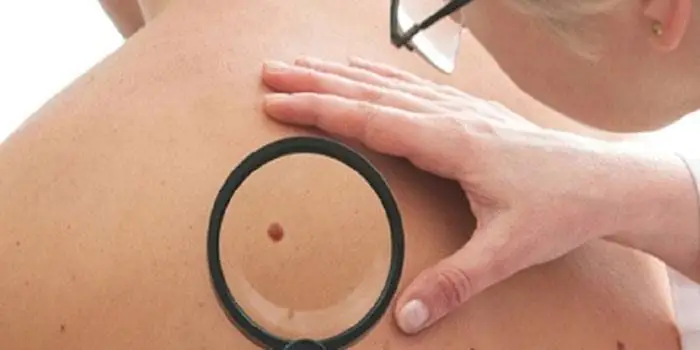
Why are moles dangerous?
Not a single person is protected from the sudden proliferation of cells of a harmless mole. Melanoma is an extremely serious disease. Changes not detected at the initial stage can result in death. The provoking factor is unsuccessful independent removal of tumors. Moles are dangerous because of their ability to:
- transform into an atypical – precancerous form;
- grow to large sizes;
- turn into cancerous;
- with minor external changes, metastases actively spread throughout the body through the circulatory and lymphatic channels.
How quickly does melanoma develop from a mole?
The transformation of a nevus into a cancerous formation can occur in different ways. The process depends on the stage of the disease and the type of tumor. Instant metastases are dangerous. Begins:
- growth of cancer (oncological) cells in the deep layers of the epidermis;
- their entry into the blood and lymph;
- penetration into the lungs, liver, kidneys;
- growth in these organs;
- complete damage to the body;
- death.
The growth phases of pigment cells are observed, along which melanoma develops from a mole. There are varieties:
- horizontal– damage to the upper layers of the skin occurs, lasting up to 10 years, but metastases do not appear;
- vertical– accompanied by the spread of cancer cells throughout the organs, can last two years, has an unfavorable prognosis;
- nodal – especially dangerous – characterized by deep spread within two months.
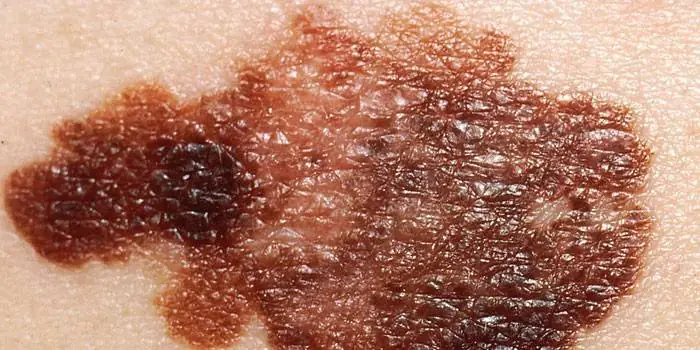
The first signs of melanoma
The patient can be assisted only when suspicious changes begin to be identified. The diagnosis, research, and referral for surgical treatment save a person’s life. The first signs of melanoma:
- increase in the height of the tumor;
- bleeding;
- the appearance of discharge;
- redness;
- burning, itching;
- swelling of tissues;
- softening of the nevus;
- the appearance of a crust;
- thickening;
- hair loss;
- expansion of pigmentation around the lesion.
With the further development of dangerous melanoma, the following are observed:
- significant change in size;
- the appearance of pain;
- enlarged lymph nodes;
- surface ulceration;
- formation of new foci;
- bleeding from places of pigmentation;
- liquid separation;
- skin thickening;
- the appearance of an earthy tint;
- signs of metastases are chronic cough, weight loss, cramps, headaches.
How to distinguish a mole from melanoma
To recognize which moles are dangerous and which are not dangerous, you need to know what they look like. A person with nevi, in order to eliminate terrible consequences, must constantly monitor the appearance of new formations and changes that occur. You can distinguish a mole from melanoma by its signs. Non-dangerous neoplasm:
- symmetrical;
- with smooth edges;
- uniform in color;
- with dimensions not exceeding 6 millimeters.
Features of dangerous melanoma that require seeking help from dermatologists:
- growth in a short time;
- pronounced asymmetry of shape;
- heterogeneity in color - the presence of inclusions of several shades;
- lack of clear boundaries - the contour line is blurred, jagged, and looks like a coastline on a geographical map;
- increased diameter over six millimeters;
- variability of any parameters - color, size, shape.
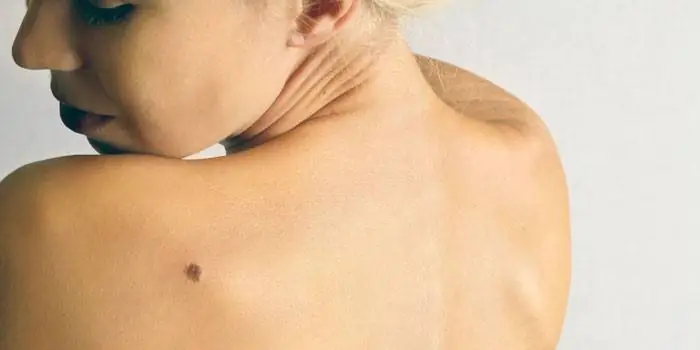
What dangerous moles look like
What do nevi that are subject to pathological changes look like? Only a doctor can correctly distinguish between non-dangerous tumors. Dangerous formations look like this:
- blue– compactions under the skin with clear boundaries, with dimensions no more than 10 mm;
- nodal– round, flat in shape, color – brown, black;
- cutaneous– often pale, convex;
- halo nevus – pigment surrounded by a light or white rim;
- spitz- looks like a dome-shaped tumor of pink shades, with the possible presence of a hole through which blood and liquid leak;
- connecting- connect individual entities into a whole.
Mole with jagged edges
One of the signs of a non-hazardous formation turning into a dangerous one is a change in contours. It often has blurred edges and scalloped borders. There are non-dangerous types of nevi - dysplastic. Only a specialist can make a correct diagnosis. A mole with uneven edges can be dangerous if there are additional signs of melanoma:
- accelerated changes in size;
- the presence of clearly defined asymmetry;
- the appearance of highly indented boundaries.
Rough mole
Such a neoplasm is harmless if its diameter is no more than 5 mm and remains constant in size. Often its appearance signals a lack of vitamins and nutritional disorders. Doctors advise coming for a consultation if it is discovered that:
- the smooth nevus turned into a rough one;
- bothered by burning, itching, tingling;
- irregularities and compactions appeared in the middle;
- areas with different shades formed;
- diameter has increased significantly.
A dangerous rough mole requires immediate examination if:
- the appearance of bleeding;
- development of the inflammatory process;
- rapid change in size;
- formation of asymmetry;
- formation of purulent discharge;
- the occurrence of painful sensations when touched;
- the emergence of an irregular shape, blurred boundaries, along the edges of the neoplasm.
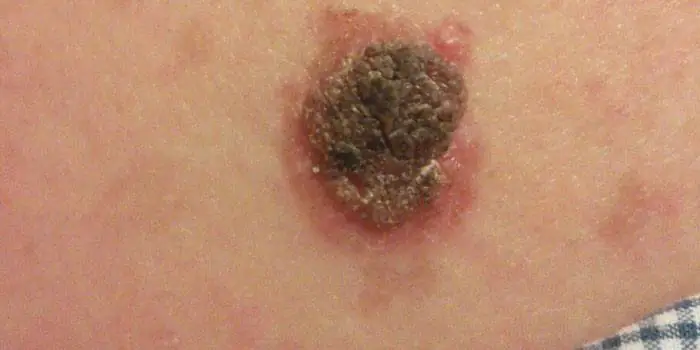
Large moles
Large formations on the skin are pigment spots. When they remain unchanged and do not cause inconvenience, this is a harmless phenomenon. It is important to constantly monitor their appearance, color, and size. To eliminate worries, you need to consult a dermatologist. During the visit, the specialist will conduct a diagnosis and give a forecast of the risk of developing a malignant neoplasm. Large moles become dangerous if they:
- injured;
- thickened;
- started to itch;
- were unsuccessfully removed independently;
- changed in size, shape;
- are bleeding.
What moles can be removed
Often nevi cause trouble for women when they are in a visible place - the face, neck. Even if they do not bother you, using removal will be the right decision - the appearance will improve significantly. After the procedure, the doctor must send the tissue for histological analysis to decide whether the mole is malignant or not. If the neoplasm is not dangerous, does not bother you, and does not change in size, surgery is not required. What moles cannot be removed? Experts believe:
- there are no contraindications;
- It is important to choose the right excision technique.
You should be careful about skin growths; it is unacceptable to remove them yourself. Only the doctor will determine whether a nevus is dangerous or not and decide what to do with it. You can delete it if:
- injured from clothing - on the neck, in the groin area, under the armpits;
- cause pain when touched;
- are located under the hair on the head and can be damaged when combing or cutting;
- change color, shape, outline;
- significantly increase in size;
- characterized by the presence of burning, itching;
- accompanied by inflammation and bleeding.
Almost every person can have one or several moles on their back. Such formations on the skin are considered a normal phenomenon that can accompany a person from birth and do not pose any danger to him. But if a mole on the back begins to change its shape, color or structure, you should treat this with special attention and see a specialist. Otherwise, you may face serious consequences in the future.

What a mole on your back can tell you
The appearance of a mole in the back area is most often associated with a person's prolonged exposure to direct sunlight. Sometimes such formations can begin to appear during hormonal surges. This applies most to teenagers in their growing years and women expecting a child. Few people know that a birthmark can form when inflammatory processes begin to occur inside the body.
If such a growth appears in people at a fairly mature age, we may be talking about the development of some kind of internal disease. Birthmarks located specifically in the upper back may indicate problems with the lungs.

Female representatives whose entire back is covered with moles may suffer from bronchial asthma and often suffer from bronchitis. As many experts note, children who have one or several birthmarks on their backs are more susceptible to colds than others. Their immune system is weakened, their blood pressure is low, so they regularly experience physical weakness in the body. Formations on the back come in different sizes and types. They can be:
- large;
- small;
- convex and flat;
- red;
- brown and black;
- with smooth and fuzzy edges.
Moles on the back have their own special meaning and help not only to characterize their owner, but also to warn him about possible difficulties. But at the same time, it is necessary to take into account in which particular zone the birthmark is located.
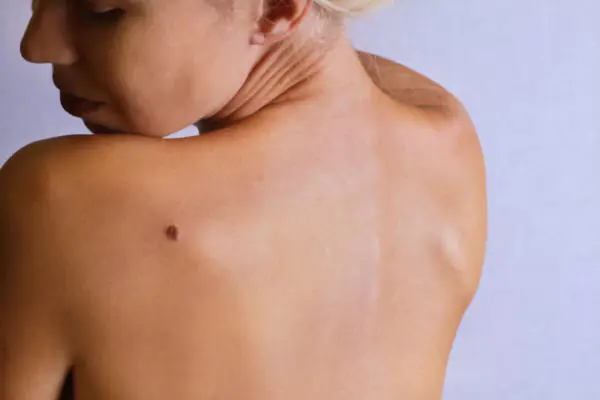
Black mole on the back
A black formation does not pose a threat to human health if it does not manifest itself in any way and its size does not exceed four millimeters, while the surface remains smooth and completely flat. A nevus of this color may indicate that a large number of melanocytes accumulate inside.
The substance melanin directly affects the hue and color saturation of the pigment spot. However, if a mole suddenly turns black and changes its size and shape, then we may be talking about health problems. Also, such changes may indicate that the nevus has begun to degenerate into a malignant formation.
Typically, black moles in men and women are congenital. They appear on the skin surface before reaching the age of sixteen. But if such a spot has already appeared in a mature person, then it is worth paying a visit to the doctor.

For what reasons did a black mole appear?
The transformation of a brown nevus into a black mole can occur under the influence of certain external factors. The main reasons for this change are:
- Hormonal surges. Quite often, black birthmarks can appear in adolescents during puberty. Women who are pregnant or facing menopause can also encounter them.
- Exposure to ultraviolet rays. With prolonged exposure to the sun, the substance melanin begins to be intensively produced in the skin layers. As a result, melanocyte cells are activated and thereby contribute to the coloration of the nevus black. It is this type of mole that is most likely to degenerate into cancer cells.
- Mechanical damage to the nevus. A large and convex mole on the back can be injured when changing clothes and playing sports. Subsequently, this can lead to significant darkening.
- Past illnesses. Some illnesses that occur with complications can provoke a special reaction from the body. As a result, birthmarks on the skin surface begin to change color.
Knowing all these factors, you need to try to keep an eye on the spots on your back. If the nevus begins to darken, you need to limit exposure to the sun and not wear tight clothes or underwear that compresses the skin.

Large mole on the back
A large mole is considered to be one whose size exceeds six millimeters. If you find such a spot on your back, you shouldn’t immediately panic. It can be completely safe if its structure does not change in any way. However, care must be taken to ensure that the size of such a birthmark does not increase in the future.
The greatest threat is posed by large moles that are dark in color: gray, dark brown, purple, black.
They can subsequently degenerate into melanoma, which indicates the onset of skin cancer. To protect yourself and get rid of all doubts and fears that arise, if you discover a large dark mole, you should see a dermatologist. The specialist will conduct an external examination of such a spot, as well as perform a biopsy and examine the tissue in the laboratory. Diagnostic measures make it possible to determine the histological type of the spot and determine how dangerous it can be.
Many moles on the back
Some people who have a lot of moles on their backs immediately begin to panic, giving this phenomenon a dangerous meaning. In fact, if birthmarks appear throughout life, they do not pose any threat. But if within one to three months a person suddenly discovers an increased number of such spots, then this phenomenon should not be ignored.
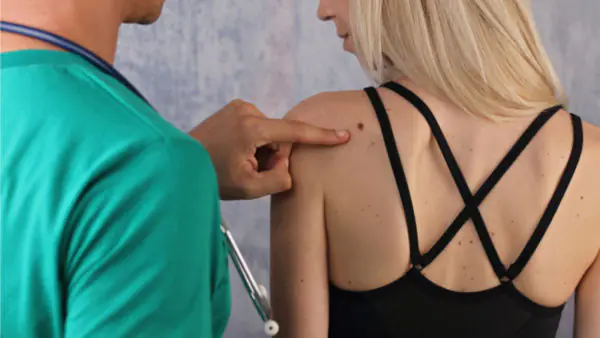
You definitely need to see a doctor. A large number of moles can appear due to prolonged exposure to the sun. Sometimes the trigger can be a sudden change in climate.
In some cases, an increased number of nevi in the back area may indicate serious skin diseases, as well as malfunctions occurring with the human immune system. The phenomenon may signal malignant formations that have appeared in the tissues of internal organs.
Dangerous moles on the back
The most dangerous are those birthmarks that quite suddenly begin to degenerate into other formations and greatly change their appearance. A nevus that poses a threat to humans can be recognized by the following signs:
- the mole begins to hurt and cause significant discomfort;
- unbearable itching appears in the area of such a spot;
- the formation increases in size in a fairly short period of time;
- Bulges, crusts, tubercles, and ulcers may appear on the surface of the nevus.
All these signs clearly indicate that an ordinary harmless mole has begun to transform into a malignant tumor. It is sometimes difficult for a person himself to pay attention to such changes in a timely manner.

A spot with absolutely smooth, regular edges should also arouse suspicion, if other moles have uneven and slightly curved edges. Such an ideal spot, arising among non-ideal formations, can also be considered dangerous.
A mole is growing - it’s unsafe
Moles on the back cannot all be the same size. Some of them rise slightly above the skin, and some have a completely flat surface. Nevi differ in shape and color. Sometimes a birthmark can decorate a person, giving him his own certain zest, and sometimes they significantly spoil the appearance of their owner.
If the birthmark begins to progress and increase in size in adulthood, then this should be treated with caution. Such changes may indicate malignant processes occurring inside the nevus tissue. Particularly dangerous are the spots, which not only become larger, but begin to hurt and itch, thereby causing great discomfort to the person.
Reasons for the growth of moles
A sharp and noticeable increase in the size of a birthmark on the back is associated with a malignant process occurring in the layers of the epidermis. If at the same time the mole changes its color and shape, then we can talk about skin cancer. However, this does not mean that any enlarged spot signals oncology. Sometimes the following factors can provoke a condition in which the nevus becomes larger:
- Mechanical damage. If a mole was accidentally touched or subjected to prolonged friction on clothing, then it may begin to grow. Even strong pressure can trigger this process.
- Prolonged exposure to the sun. If a person is fond of tanning and often visits the solarium, then he also runs the risk of his moles increasing in size. To prevent this, you should use a protective cream while sunbathing.
- Pregnancy period. For some women, while expecting a child, significant hormonal changes begin to occur within the body. Such hormone surges lead to the fact that the birthmark can increase in size and the spots become much larger than there were before.

Sometimes a person does not even notice the process by which his birthmark increases in size. If it is nevertheless discovered that the nevus has become much larger, you should not immediately think about oncology. It is necessary to exclude other provoking factors.
What to do with a suspicious mole
If the birthmark suddenly begins to increase in size, its edges are uneven and the color darkens, then you should consult an oncologist. You should not wait until the mole begins to transform into a malignant tumor. It is better to recognize this disease in the early stages of its manifestation.
It is also under no circumstances recommended to try to remove such a stain yourself. This is fraught with serious complications and consequences. It is better not to touch such a formation at all, not to smear it or subject it to any mechanical damage. And you will need to avoid being in direct sunlight for some time, until the doctor determines the nature of the nevus.
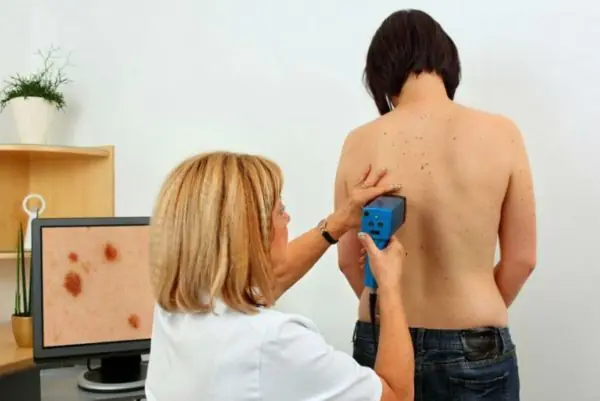
Treatment of suspicious and malignant moles
Moles that are suspicious should only be treated by a qualified doctor. Doing therapy at home is not recommended. Typically, the treatment process is based in this case on surgical removal of the growth.
The operation itself is considered simple. It is based on the excision of a mole, especially when it comes to the back area. First, the doctor determines the histology of the formation, and then selects the most suitable method of therapy. In this case, the individual characteristics of the body and the presence of concomitant diseases must be taken into account.
Prevention of melanoma
To protect yourself and reduce the risk of a mole degenerating into a malignant tumor, a person is advised to be more attentive to his health and lifestyle. After swimming in rivers and open reservoirs, you must take a shower and wipe the skin surface dry.
In very sunny and hot weather, do not forget to use special skin protection products. If possible, you should avoid visiting the solarium. Once a year you should show your large moles to a dermatologist or oncologist. These simple rules will help protect yourself from skin cancer.
All iLive content is reviewed by medical experts to ensure it is as accurate and factual as possible.
We have strict sourcing guidelines and only link to reputable sites, academic research institutions and, where possible, proven medical research. Please note that the numbers in parentheses ([1], [2], etc.) are clickable links to such studies.
If you believe that any of our content is inaccurate, out of date, or otherwise questionable, please select it and press Ctrl + Enter.
Healthy skin is a decoration for any person. But various growths may appear on it, most often these are nevi. Let's consider what to do in such a situation and how to recognize pathology?
Almost everyone has birthmarks; they differ in color, size and location. In most cases, they do not interfere, and we calmly get along with such features of the skin. But this is not always correct, since under certain conditions the growths can change their color and size, that is, degenerate into malignant neoplasms.
If the nevus is not in a visible place, does not cause inconvenience and is not injured, then most often it is not paid attention to. But if there are any changes in its color or size, then this is a reason to go to the hospital.
A dermatologist can tell you why a mole has grown and what to do with it, and if necessary, give a referral to a surgeon or cosmetologist. Although the risk of transformation of pigmented formations is small, preventive visits to the doctor will help reduce it to a minimum. In addition, promptly seeking medical help and early diagnosis of melanoma provide a good chance of completely getting rid of cancer.
ICD-10 code
Reasons for the growth of a mole
There are many factors and reasons that cause the growth of melanocytic cells. It is not necessarily due to their malignant degeneration. Most often, an increase or the appearance of a new nevus is associated with trauma to the skin, for example, during cosmetic procedures, various endocrine and hormonal factors, and much more.
[1], [2], [3], [4], [5], [6]
Can a mole grow?
Birthmarks are rightfully considered a natural decoration of the skin. They appear and disappear throughout our lives. Therefore, if the question arises whether a mole can grow in an adult, then the answer is unequivocal - yes. Congenital nevi are considered less dangerous, since they rarely degenerate, unlike those that occur at an older age.
A normal pigmented neoplasm is small in size
iLive does not provide medical advice, diagnosis or treatment.
The information published on the portal is for informational purposes only and should not be used without consultation with a specialist.
Please read the site rules and policies carefully. You can also contact us!
Copyright © 2011 - 2019 iLive. All rights reserved.



